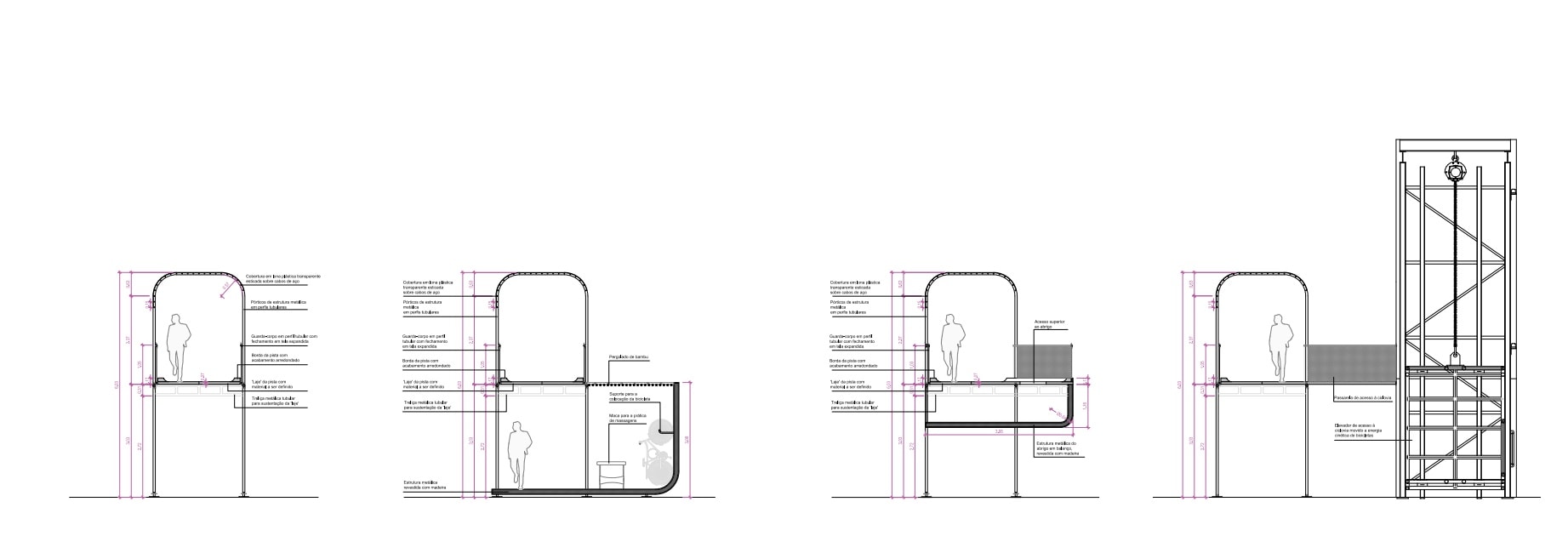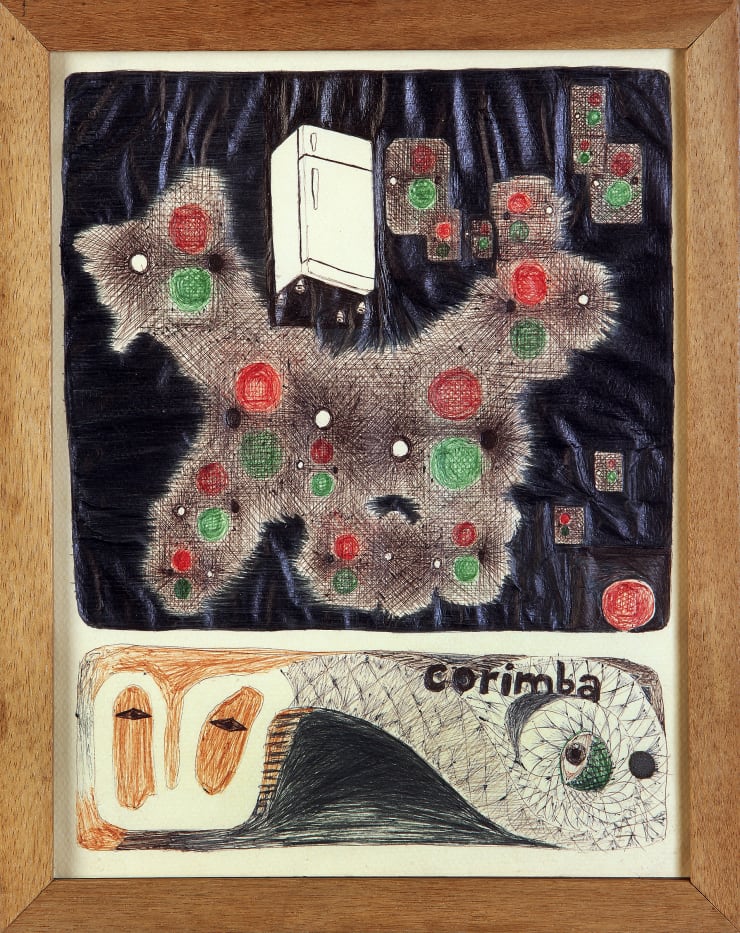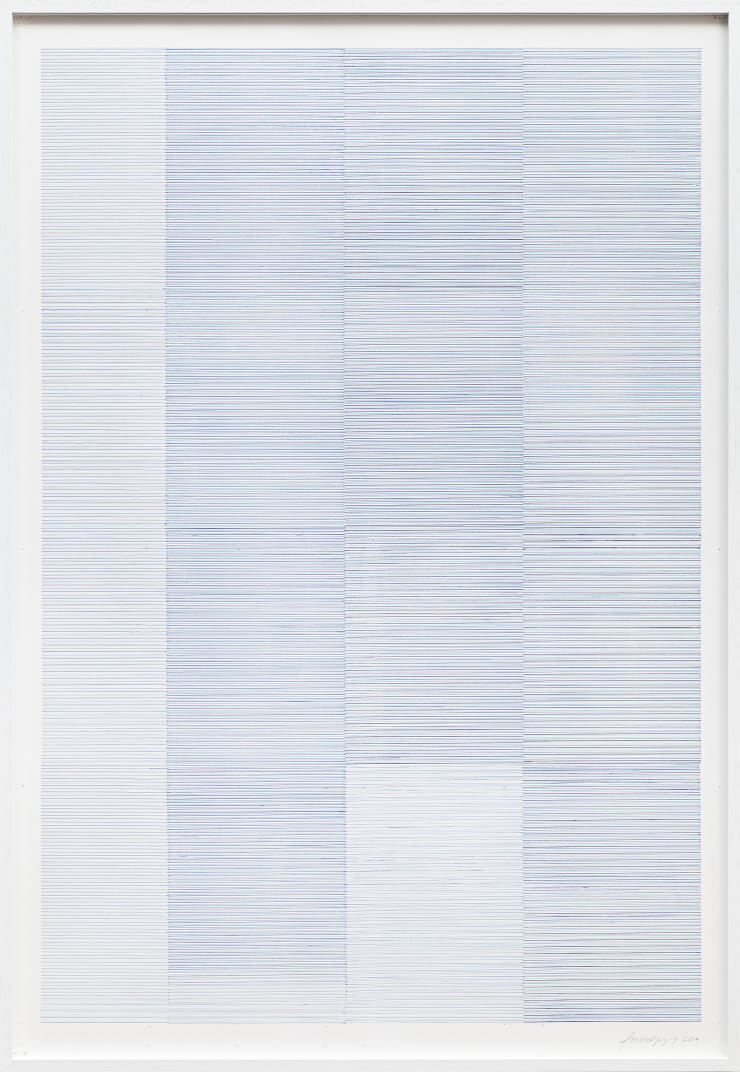
-
Jarbas Lopes presents the Trecho Inaugural [MAM - Rio de Janeiro], a work that establishes, in a closer way, the visualization and practice of the original proposal of the CicloviAérea, revealing, for the reality dimensions, its ideals. It is a structure that is both aesthetic and functional, designed for the exercise of interactive contemplation that consists of an aesthetic vision of the future for today.
-
-
The Inaugural Section is a fundamental development of the CicloviAérea project, taking on various aspects of actions in the expression of art in its development, ranging from the creation of an imaginary, supports and contexts which simultaneously explore its poetic and conceptual dimension, to go further on the practical aspects, precursors of its material realization, which encourages dialogues for possible utopian senses.
The structure, designed in partnership with Thorsten Nolte of the architecture office Lampreta Nolte, is composed of two plans - Elevated plan: with the bike lane, a large square with stairs, two smaller squares, two shelters for sleeping or resting and an elevator to people with special needs. And the Plan on the ground level (below the elevated plan): two bathrooms, a sauna, a large square, a shelter for the practice of massage and a space for cultural and multifunctional exchanges, containing a bicycle repair shop. The structure will also have its own renewable electric energy system, generated by solar panels and wind energy.
The project aims to create the work of art Trecho Inaugural da Cicloviaérea, and its exhibition for 3 months in the external area of MAM in Rio de Janeiro, in order to promote a reflective and interactive experience about the phenomena of cities, of the relationship with the public space, on mobility and sustainability. Creating an art event open to artistic collaborations and in direct dialogue with different technologies, which starts from the experimental dynamics, having as a conductive action, the possibility of the public circulating on the elevated track in 16 bicycles that will be available, plus the realization of a seminar.
The entire experience will be allocated and expanded on a website and the issues involved in the event of a seminar entitled Utopias Possíveis na tecnologia do corpo, complementing a round of thoughts and actions on aspects of contemporary art.
-
CICLOVIAÉREA
2001 renewed fiction for everyday life.
CicloviAérea is an art project that consists of an aesthetic vision of the future for today. An idea conceived in the creation of an imaginary that aims the real construction of elevated bike lanes to promote and facilitate the use of the bicycle within the daily life of urban transactions and the development that this can provide, with the issues that this practice involves. At CicloviAérea you have fun, art and leisure.
Nascicloviaerea
A human construction that deviates from the apocalyptic feeling, reconciling and showing the Technology of the Body, the body where everything passes, in its full functioning, in spirit, in movements, in the effort that goes beyond the muscular and the economic, without combustion, with sympathy, empathy, telepathy, ancient techniques of yoga, singing, dancing and meditations. The body flowing the energy of the body, the body flowing the mechanical energy of the bicycle. The idea of CicloviAérea presents this symbiosis, between man and machine, as the first expression of a more comprehensive harmony, of the subject with him or herself, with the other, his or her community and the natural environment.
It is a public architectural intervention, materialized on a suspended track that will facilitate bicycle traffic in urban daily life, in search of a positive response to the desires of social coexistence, with the basic reason of effecting, affectively, the use of the bicycle on the daily routine. A bridge that reconnects people to the natural environment and to their own bodies, supported by current and vast technological achievements.
The vision of the future for the present, establishing balance, in body technology, pleasure and effort without combustion, 50% man, 50% machine. With the speech of art based on collaboration, opening space for the meeting, the collective work and strategies – raise the track to establish a new plan for the city – for a lighter plan, making use of high technology, avoiding major impacts on the ground and in the environment.
Planning the city, encouraging a clean means of transport, suspended lanes for cyclists over the city, connecting places independent of the flow of cars, takes you wherever you go, on a light path in your favor, sculptural-architectural work mixed with the continuity of what is around, the landscape.
Since 2001 – the first year of the second millennium –, that the CicloviAérea proposition has been developed (when it was launched publicly when the first work created, a CicloviAérea bicycle, was shown at Centro Cultural São Paulo), creating a collective imagery close to the real space, with Listed Texts, Drawings, Bicycles, Fanzines, Models, Mobile Experimental Section and Inaugural Section, actions and exhibitions.
[A ideia da CicloviAérea por Jarbas Lopes]
[Text das ist Samba? Samb(ist)a Luis Andrade / outubro 2007]
Samba
Fenômenos da Arte
Ficha Técnica
-
CicloviAérea series bicycles - Active for use, allow an aesthetic experience that extends itself to public interventions, spreading a conversation about the proposals of the CicloviAérea in the streets. Bicycles are handcrafted with wicker or rubber wefts. They symbolize the precursor image and the material realization of the idea of the CicloviAérea; 50% man 50% machine.
Papo de bicicleta
-
Pathways drawings, via imagination, that reflect and create the abstract imagery of the CicloviAérea. They are conceived by the dialogue between forms and thought, mainly influenced by the feeling that what inhabits thought, the CicloviAérea, is already done, being lived on a daily basis, feeding a flow of stimulus and ideas for this drawing conversation, reinforcing even more the exercise of this language, innate to all people, as an instigating dynamic for thought.
The drawings are made with ballpoint pens, in the four basic colors, blue, red, black and green, on A4 paper in different colors.
-
The Trechos Experimental Móvel is an installation that opens the first step towards the real practice of the CicloviAérea project, elaborating an exercise of the proposal of elevated cycle paths in the public space. Promoting an affective event of meetings around creative collaborations in the expression of art, music and poetry. It consists of a removable iron and wood structure, measuring 60m x 1.60m x 1.00m and was first tested in 2008 in Maricá, followed by several other cities, in downtown Rio de Janeiro in 2009, in Santiago, Chile in 2010, at Ibirapuera Park in São Paulo in 2011, in Brasília in 2013, in Curitiba in 2014 and at the Sesc Belenzinho São Paulo in 2017.
-
Plano Real are sculptural works that enable the visualization of the project on a smaller scale, composed of the architectural model project elaborated by Jarbas in partnership with Lampreto Noltes office.
-
CicloviAérea has participated in several exhibitions in Rio de Janeiro, São Paulo, Curitiba, Berlin, Santiago de Chile, Phoenix - USA. Having also participated in the Bienais de São Paulo on the 27th in 2006 and of Habana-Cuba in 2005. The works, Bicycles and Drawings of this series are found in several public and private collections, among which we highlight the Inhotim Institute in Minas Gerais-Brazil, in Moma and at the Bronx Museum - New York-USA.
-
-
below I leave some references of other works that dialogue with the proposal:
-
Lives and works in Maricá - Rio de Janeiro. Brazilian artist, moves ideas, reframes objects, idealizes magic and expands, based on his works, the concept of possible utopias. His creative process permeates a reconfiguration of objects and aesthetic experiences, giving them a new meaning and movement, always around a critical tone. His sculptures and interactive paintings make a balanced fusion between time, space and practical and ideological circumstances such as collective participation, sociability for public spaces and shared uses of the city. The artist uses this power to work and stretch plasticity to maximum tensions, his work “Cicloviaérea”.
In 2020, he hold his third individual exhibition at A Gentil Carioca. In 2019 he took part in the exhibition "Samba in the Dark", at the Anton Kern gallery, in NY, "Brazil! Foco on na Arte Contemporânea Brasileira" at the Museo Ettore Fico, in Turin, Italy and " O que não é floresta é prisão política" in the Occupation 9 de Julho from Movimento dos Sem Teto do Centro (MSTC) in São Paulo. His works were also showed at the III Bienal de Gaia, in Vila Nova de Gaia, Portugal. In 2018, during the exhibition "Via Aérea" he performed an artistic intervention in the external courtyard of Sesc Belenzinho, in São Paulo. In 2017 he presented the solo shows “XXXY”, at the gallery A Gentil Carioca in Rio de Janeiro, “Circulovisão” at the gallery Luisa Strina, in São Paulo and “e a u”, at the CRAC Alsace, Altkirch, in France. In 2016 showed the solos “SOLTO”, at the SESC Nova Iguaçu, “E de novo montanha, rio, mar, selva, floresta”, at the SESC Palladium, Rio de Janeiro and the “Solo Presentation”, at gallery A Gentil Carioca during Art Basel, in Switzerland.
His works are part of several art collections as Instituto Inhotim, Brumadinho, Minas Gerais, Brazil; Gilberto Chateaubrian Collection I MAM Rio de Janeiro, Brazil; Museum of Modern Art of São Paulo, Brazil; Brazilian Arts Association, São Paulo, Brazil; Pampulha Art Museum, Belo Horizonte, Brazil; Funarte/IBAC, Rio de Janeiro, Brazil; Georgia Museum of Art, USA; Arizona State University Museum, USA; MoMA Museum of Modern Art, USA; The Cisneros Art Foundation, USA; Henry Moore Foundation, England; Victoria and Albert Museum, England; Fundación ARCO, Spain; TBA21 Thyssen Bornemisza Art Contemporary, Austria.



























